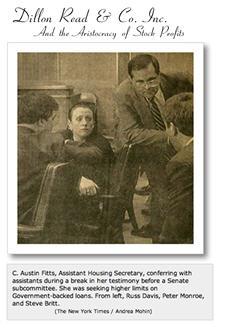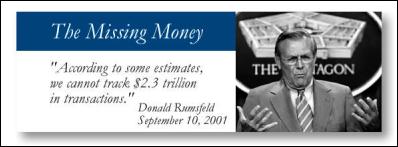Real Deal: Where is the Money? Let’s Get it Back!
Summary: Media revelations are unfolding daily regarding losses in the U.S. mortgage market. These losses are not a new phenomenon. Rather, they represent the latest phase in an ongoing tradition of institutionalized fraud in the U.S. mortgage system and the federal credit system that directly and indirectly guarantees it. An understanding of this history can mobilize public support for reforms that address root causes by reversing the profitability enjoyed by those responsible.
Where is the Money? Let’s Get it Back!
by Catherine Austin Fitts
February 5 2008 - Original URL
Large banks now claim recent losses in the US mortgage market totaling over $100 billion. While amounting to only a small percentage of banking profits over the last decade, this is still a lot of money. It may pale by comparison, however, to the losses the banks’ customers, the communities drained by predatory lending and investment practices and the citizens who stand behind the federal credit may incur.

Municipalities from Australia to Montana are reporting losses on U.S. mortgage and structured investments sold to them by the banks. (1) (2) Just as small towns in the Norwegian Arctic Circle reported losses of $167 million on investments packaged by Citicorp, Citicorp’s departing CEO exited his job with a $100 million compensation package.
The City of Baltimore is suing Wells Fargo. The City of Cleveland is suing them as well, as part of the city’s suit against 21 Wall Street banks, a veritable who’s who of U.S. mortgage lending and securities, including JP Morgan Chase, Citicorp and Goldman Sachs, arguably the most prestigious member banks of the New York Federal Reserve Bank, the depository for the U.S. government.
According to the Baltimore lawsuit, nearly 450,000 properties were in some stage of foreclosure during the third quarter of 2007. The Baltimore lawsuit cites a recent study of Chicago communities in which it was estimated that each foreclosure is responsible for an average decline of approximately 1% in value of each single-family home within a quarter of a mile.
While the financial community holds its breath waiting for pension fund annual reports to disclose what may be the most significant losses, the stock market continues to drop, evaporating the wealth of millions of investors in America and around the world.
 The
state pension fund lawsuits over stock portfolio losses have
begun. The Ohio Public Employees Retirement System is
suing Freddie Mac, and Norfolk County Retirement and the New York
City and State Pension Funds are suing Countrywide.
Ultimately, pension stock portfolio losses will be
insignificant compared to the fixed income portfolio losses
expected to wipe out billions in retirement savings.
The
state pension fund lawsuits over stock portfolio losses have
begun. The Ohio Public Employees Retirement System is
suing Freddie Mac, and Norfolk County Retirement and the New York
City and State Pension Funds are suing Countrywide.
Ultimately, pension stock portfolio losses will be
insignificant compared to the fixed income portfolio losses
expected to wipe out billions in retirement savings.
The last time the U.S. media exposed mortgage fraud of this magnitude was in 1989. In April of that year, I was appointed Assistant Secretary of Housing/FHA Commissioner at the U.S. Department of Housing and Urban Development (HUD) only to find that the FHA single family mortgage insurance fund, required by law to be financially sustainable, was losing $11 MM a day and that the combined FHA mortgage insurance funds had lost $2 billion in the Texas region alone over the prior year. The mortgage fraud at HUD, one of the largest issuers of mortgage securities in the world, was so bad that Secretary of Treasury Nicholas Brady privately tried to dissuade me from joining the agency, saying “You can’t go to HUD — HUD is a sewer.”
The HUD losses were a drop in the bucket compared to the losses on the savings and loan institutions, ultimately costing U.S. taxpayers an estimated $500 billion by the time the clean-up was through in the mid 90’s. This estimate did not include the subtle and more expensive inflation borne by ordinary citizens, resulting from allowing the large financial institutions to use the federal credit to borrow inexpensively in the short-term markets and reinvest in long-term U.S. Treasury and agency securities, helping some of them dig out of the losses and resulting in windfall profits to the industry across the board.
Policymakers encouraged those of us leading the last clean-up to fashion reforms such that mortgage fraud on this systemic scale “could never happen again.” And so significant financial reforms were legislated and instituted.
First and foremost, were laws requiring federal agencies and credit programs to produce audited financial statements. As a significant amount of the US mortgage market enjoys direct or indirect support of federal credit programs, such an audit requirement should ensure that any problems in the housing finance system are illuminated early on. Part of this reform, so-called “paygo,” (The equivalent of “loan loss reserves” required of private lenders) would make it prohibitively expensive for Congress to extend federal credit to support a new bubble.
Second, were administrative steps to ensure transparency of federal mortgage credit and spending by county and zip code. The most effective internal control is knowledgeable citizens, watching the use of government resources on their home turf. With easy access to data about government resources expended locally, communities could assess the performance of their tax-supported housing and mortgage resources contiguous to the areas in which they live, work and vote for political representation. Without access to such “place based” financial information, it is difficult to hold our legislative representatives accountable.
What happened? Beginning in 1995, numerous government agencies and the US Treasury began annual announcements declining to publish audited financial statements. In the process of explaining itself, HUD announced “undocumentable adjustments” to balance its books in 1998 and 1999 of $17 billion and $59 billion, declining to give a total for the undocumentable adjustments in 2000. In the process, the Office of Management and Budget solved the loan loss reserve problem by cooking the assumptions used to estimate costs, thus permitting issuance of greater amounts of mortgage credit with lax terms and conditions. Things got so bad that the chief of staff to the chair of the Senate Appropriations Subcommittee in 2000 confessed to me “HUD is being run as a criminal enterprise.” The myths that there was a budget surplus during the Clinton Administration or that the housing bubble began after the Clintons left office represent the partisan fantasies of Americans desperately searching for ways to avoid facing the real risks before us.
Even more money was missing at the Department of Defense (DOD). On September 10, 2001, Secretary of Defense Donald Rumsfeld conceded, “According to some estimates, we cannot track $2.3 trillion in transactions.”
By 2003, more than $4 trillion of “undocumentable adjustments” had been reported at HUD, DOD and NASA alone. Since then the federal government fails to account for additional billions each year as the U.S. commitment in Iraq leads to unprecedented spending with third party contractors, many under “no bid” contracts and without meaningful contracting supervision. Finally, after years of manipulation in the precious metals markets, serious concerns are growing about the status of the US gold stores. Has our gold gone missing as well?
 In the 2007 Financial Report, the U.S.
Comptroller General stated “Certain material weaknesses in
financial reporting and other limitations on the scope of
our work resulted in conditions that, for the 11th
consecutive year, prevented us from expressing an opinion on
the financial statements…”
In the 2007 Financial Report, the U.S.
Comptroller General stated “Certain material weaknesses in
financial reporting and other limitations on the scope of
our work resulted in conditions that, for the 11th
consecutive year, prevented us from expressing an opinion on
the financial statements…”
Meantime, efforts to bring local transparency to government mortgage programs and credit have been stopped, destroyed or reduced to ineffective window dressing. (See articles: Where is the Collateral? and So, Where is the Collateral?.) The average American has little understanding of the government resources and credit programs around them.
So our earlier reforms failed to prevent billions in subsequent mortgage fraud losses and the disappearance of trillions from US government accounts. Why? What have we learned from this failure, which would suggest lasting reforms?
If your public company were operating outside its bylaws and U.S. Securities and Exchange Commission regulations requiring audited financial statements, at some point your bank would refuse to effect your banking transactions and stop selling your securities to their customers. This means if $4 trillion is missing from the U.S. government, the federal depository and its member banks are complicit, if not responsible.
We don’t need new laws for each new crisis. We need enforcement of existing laws. What we also don’t need are bank depositories and government payment and accounting contractors who will proceed with trillions of banking transactions and government securities sales while basic provisions of the U.S. constitution and laws governing federal financial management are blatantly ignored.

http://www.solari.com/learn/articles_missingmoney.htm
In 1989, we failed to identify what money, credit and assets had been stolen and to get them back.
Billions of dollars in profits remained in the pockets of the conspirators and their co-conspirators - the investors, strategic partners and offshore backers to whom they funneled it. Rather than hold people and institutions accountable and achieve restitution, we plowed additional back door profits into the financial institutions and allowed them to continue in their role as member banks and shareholders of the New York Federal Reserve Bank, depository to the US Treasury.
These institutions continued to provide a wide number of important services to federal, state and local government and pension funds, ensuring their access to extraordinary amounts of revenues, assets and critical inside market information. We continued to accord them, their investors and the politicians they funded the prestige and power traditionally reserved for a society’s most trusted stewards and fiduciaries. By so doing, we legitimized and institutionalized mortgage and financial fraudsters on a global scale. (1) (2) (3)
Trillions of dollars are missing. Where did it go? Who has it? Let’s act on what we learned the last time around – “Crime that pays is crime that stays.” This time, let’s ask and answer the right question: “Where is the money and how do we get it back?”
 About the
Author- Catherine Austin Fitts is president of Solari, Inc.
Ms. Fitts served as Assistant Secretary of Housing during
the first Bush Administration, lead financial advisor to the
U.S. Department of Housing and Urban Development during the
Clinton Administration and is a former managing director and
member of the board of Dillon, Read & Co. Inc. Biographical
information.
About the
Author- Catherine Austin Fitts is president of Solari, Inc.
Ms. Fitts served as Assistant Secretary of Housing during
the first Bush Administration, lead financial advisor to the
U.S. Department of Housing and Urban Development during the
Clinton Administration and is a former managing director and
member of the board of Dillon, Read & Co. Inc. Biographical
information.


 Keith Rankin: Geopolitical Fractures, And Untidy Yet Workable Solutions
Keith Rankin: Geopolitical Fractures, And Untidy Yet Workable Solutions Gordon Campbell: On Winston Peters’ Battle Against The Phantom Legions Of The Woke
Gordon Campbell: On Winston Peters’ Battle Against The Phantom Legions Of The Woke Adrian Maidment: Road Cone Final Exam & Donald, I Warned You!
Adrian Maidment: Road Cone Final Exam & Donald, I Warned You! Binoy Kampmark: The Script Of Anxiety - Poland’s Nuclear Weapons Fascination
Binoy Kampmark: The Script Of Anxiety - Poland’s Nuclear Weapons Fascination Martin LeFevre - Meditations: Regarding Randomness And Significance
Martin LeFevre - Meditations: Regarding Randomness And Significance Ian Powell: When Apartheid Met Zionism
Ian Powell: When Apartheid Met Zionism